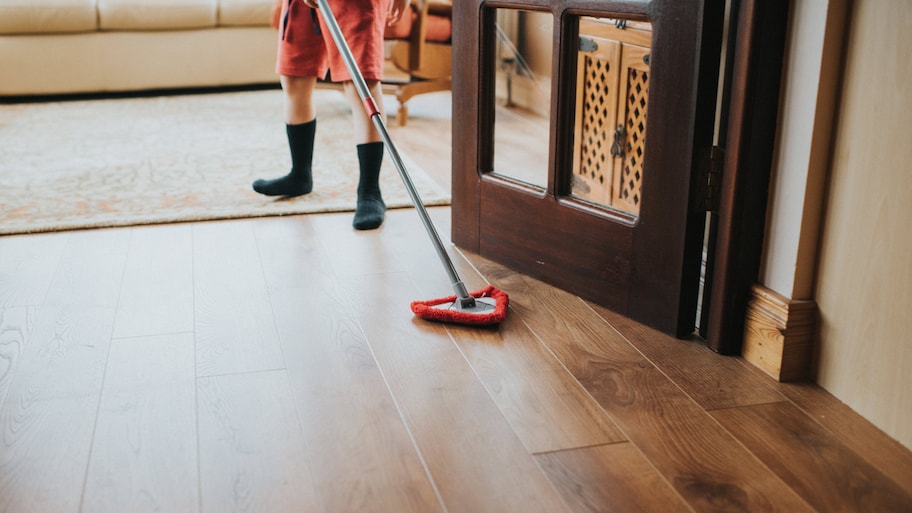Caring for this part of your home doesn’t have to be hard
Hardwood floors increase your home’s resale value and add a classic touch to your space. And while hardwood floors can last decades, they do require a bit of maintenance to look their best through the years. Fortunately, you often won’t need to call in a pro to fix minor flooring damages, and there are preventative measures you can take to ensure no scratches or stains pop up in the first place.
This guide will walk you through all your options when it comes to how to care for your wood floors, from creative ways to fill in cracks to which cleaners you should (and shouldn’t) use.
Why Do I Have to Care for Hardwood Floors?
Although hardwood floors are durable, they’re not invincible. Without routine care, you’ll notice the quality becomes not-so-great over time. And even when the floors are properly finished, sealed, and installed, wood flooring is susceptible to damages like scratching, staining, and cracking (but there are a few ways to prevent this from happening).
How Much Does It Cost to Maintain Hardwood Floors?
It’s much more affordable to maintain hardwood floors than it is to repair them. If you’re regularly washing and surveying for any irregularities, the necessary cleaning supplies and tools are all you’ll need to pay for.
On the other hand, fixing things like cracks or scratches on your own will require additional purchases, like wood filler or sandpaper, but it’s still much less expensive than hiring a pro to do it for you. The cost for professional hardwood floor repairs ranges from $450 to $1,500 on average.
How to Prep Your Floors for Maintenance

Before you can start caring for your floors properly, you have to thoroughly inspect them. Doing this will show you what needs your attention so you don’t end up wasting your time elsewhere. Follow these steps to ensure that you don’t miss anything.
Find out if you have unsealed or sealed hardwood floors. Sealed wood floors have an extra layer of protection that prevents the majority of water damage, whereas unsealed floors are much more sensitive to moisture. (You can find out which one you have by placing a drop of water on the floor. If it keeps its shape, your floor is sealed. If the floor absorbs it, it’s not sealed.)
Remove clutter and rugs from the space.
Examine every plank for scratches, dents, grime, and signs of damage.
Make note of any findings that will need attention later in the cleaning process.
How to Maintain Hardwood Floors
Ensuring that your hardwood floors are well cared for requires a combination of regular cleaning and occasional minor and major repairs. Below, you’ll find all the possible scenarios that you could face, plus a solution for each and simple ways to minimize the worst outcomes.
Remove Debris as Often as Possible
Keeping your floor clear of debris is the best way to prevent dirt build-ups that will eventually become difficult to remove.
Sweep and mop up spills when they occur.
Vacuum or sweep once every two to three days.
Use a floor duster or a vacuum to suck up dust on a weekly basis.
Use a vacuum without a beater bar to prevent scratches.
Clean and Disinfect Seasonally
Even with regular dusting and sweeping, dirt and grime can accumulate on hardwood floors over time. Fortunately, all this routine care ensures that you only need to wet mop and disinfect once every month or two. A liquid solution designed exclusively to clean hardwood floors can take care of both, but there are homemade options that work as well.
Follow the tips below to properly clean and disinfect hardwood flooring:
Avoid using heavy-duty cleaning solutions. Vinegar and bleach, even if diluted, can damage the finish of your flooring with prolonged use. Using a steamer is a natural approach to disinfecting surfaces. However, wood floors are porous and excessive moisture and high temperatures can cause warping. In general, look for a solution that contains disinfecting agents and is specifically designed for wood floors.
Always make sure to check the instructions on a cleaning product. Hardwood floors can harbor bacteria and viruses like any other surface. Look for a solution that contains disinfecting agents. Follow the product’s instructions, especially if you need to dilute it.
Test the product before using it everywhere. Take your wood floor cleaning product on a test run by using its small and inconspicuous area before applying it over the entire flooring surface. That way, if it doesn’t work out as expected, you won’t have anything to worry about.
Make your own hardwood floor cleaner. Hydrogen peroxide is an effective disinfectant that’s probably in your cabinet right now. Spray a 3% hydrogen peroxide solution directly onto floors. Wipe away with a microfiber cloth after allowing the solution to sit for several minutes.
Don’t get your mop too wet when cleaning. The use of excess liquid on wood flooring can cause cracks and warping over time, so make sure to fully ring out your mop before putting it to work.
Repair Scratches and Cracks in a Few Different Ways
When it comes to fixing hardwood floor damage, you have options. From cracks to stains, here’s how to make your flooring look good as new.
Patch Cracks With Wood Filler
Deep cracks that are hard to conceal may need a bit of extra TLC, but are still something you can totally fix on your own. Find out what materials you’ll need and how to do it below.
Materials:
Sponge
Microfiber cloth
Cleaning solution
Wood filler
Fine-grit sandpaper
Wood stain
Instructions:
Start by cleaning deep into the groove of the scratch so you don’t trap any debris.
Fill the groove with wood filler and let dry. It’s ok if it’s not perfectly flush with the floor.
Once the wood filler has dried, lightly sand the top until it is smooth and even with the surrounding area.
Stain with a matching shade and seal. Let dry fully between each step.
Distress Your Floors to Camouflage Scratches and Stains
Consider this approach if your floor has more than just a few light scratches. Hand-scraping or distressing your floors to give them a worn, antique appearance can turn unsightly scratches into custom character. Here are a few different and creative ways to make your floor look purposefully distressed:
Try running a wire brush across each plank to mimic pet scratches.
A screwdriver can be used to create controlled and shallow divots.
You can even try a soldering iron to add burn marks or scars to your flooring.
Rub a walnut on scratches or stains in a circular motion. The fat in the nut will bind to the wood and make blemishes less noticeable.
Whatever approach you want to try, make sure to conduct a test run in an inconspicuous area to make sure you like the final look.
Use a Homemade Solution to Buff Out Scratches
Not in the mood to buy anything new to fix up your hardwood floors? You don’t have to! A mix of common household supplies will do the job just fine.
Combine a few scoops of baking soda with a few drops of olive oil.
Apply the mixture to scratches and let sit for several minutes.
In a circular motion, buff the mixture into flooring with a soft sponge. Remove with a microfiber cloth or rage.
6 Ways to Prevent Hardwood Floor Damage

Now that we’ve covered all the different ways to fix your floors, let’s talk about how to ensure that no damages occur in the first place.
1. Mop Up Spills Right Away
Even if they’re properly finished, wood is more susceptible to water damage than other types of flooring. Plus, colored liquids are more likely to leave an unsightly stain the longer they sit. Wipe up spills the moment they occur and use a small amount of wood cleaning solution and warm water to remove any remaining residue.
2. Open the Windows to Speed Up Drying Time
Because wood flooring is sensitive to moisture, it’s important to ensure it dries as quickly as possible after wet cleanings. Make sure all the windows in the area are open to allow for proper air circulation, and, if you have one, use a fan to speed up the drying process even more.
3. Add Protective Pads to Furniture
Even slightly moving heavy furniture without proper protection can result in devastating hardwood floor damage. Fortunately, applying sticky, protective pads to the underside of furnishings like chairs, couches, tables, bookcases, and the like will eliminate this problem entirely.
4. Remove Your Shoes
We drag in a lot of dirt and debris on our shoes, so taking them off when you enter your home is one quick way to minimize both damage and the need for cleaning.
5. Use Rugs in High-Traffic Areas
Some parts of a home see a lot of action whether you like it or not, but that doesn’t mean that their wear and tear needs to show. Placing area rugs in high-traffic areas will add a stylish flare to these spots and ensure they don’t get damaged as well.
6. Trim Pets’ Nails
Just because pets are often the culprits of wood floor damage doesn’t mean they have to be. Trimming your furry friend’s nails will prevent them from accidentally scratching up your wood floors while they walk around.
FAQs
How often do I need to refinish my hardwood floors?
Even with consistent care, hardwood floors need routine refinishing. Refinishing can give tired floors new life and is typically recommended every 7 to 10 years. Signs your hardwood floors could benefit from refinishing include excessive scratches and dents, water damage, and fading or discoloration
Can I refinish hardwood floors myself and how much does it cost?
It’s possible to refinish your hardwood floors on your own, but the process can be time-consuming and not always as inexpensive as you would hope. First, there are plenty of materials you’ll need to purchase or rent. You’ll likely need to rent a floor sander at an average of $70 for a full day, plus a deposit. Other materials, like sandpaper, stain, and varnish or polyurethane coating, can quickly add up to several hundred dollars.
While the cost to refinish hardwood floors strongly depends on square footage, you can expect to pay between $500 and $1,000 to refinish your own hardwood floors. To save time and labor, you might want to hire a professional hardwood floor refinisher near you.
How much does professional refinishing cost?
If you’ve decided that having a professional refinish your floors will be faster and more satisfactory, you can expect to pay between $1,000 and $2,500. To get a better idea of what your hardwood refinishing project will cost with a professional, multiply the project’s square footage by the average price of $4 per square foot.





